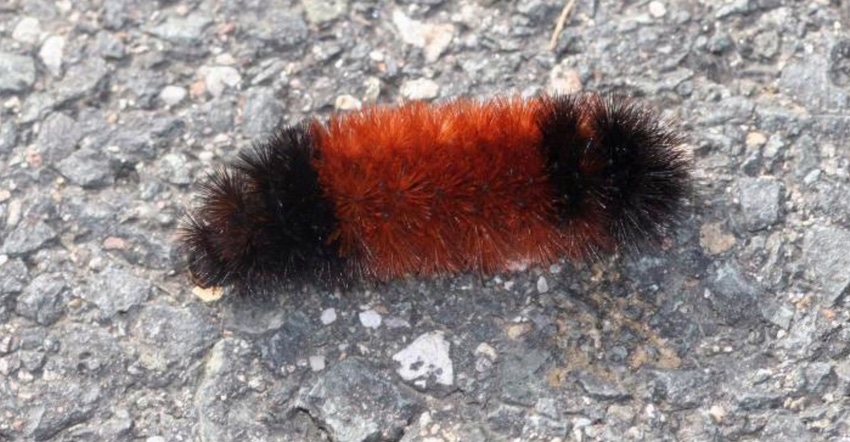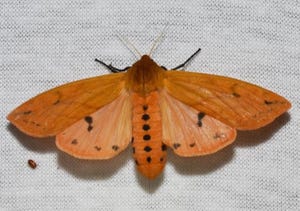
There are few things farmers like to talk about and speculate on more than the weather.
Weather is critical to a farm’s success and a major influence on each day’s events. Spending so much time outdoors lets farmers observe the environment and the critters that inhabit it. This can lead to various theories on how signs in nature can forecast the weather.
How high the squirrels are building nests, how plentiful the acorns are, how big the spiderwebs are and what the shape of a persimmon seed is all have been linked to winter weather by the folklore king of weather forecasting, the Old Farmer’s Almanac.
But one of the best known and most often cited is the stripes on the woolly bear, or woolly worm, caterpillar, the larval stage of the Isabella tiger moth. The legend says if the rusty middle band of the woolly worm is wide, the winter will be mild. The more black there is, the more severe the winter will be.
 ISABELLA MOTH: In the spring, the woolly bears spin and cocoon and transform inside to a full-grown Isabella tiger moth.
ISABELLA MOTH: In the spring, the woolly bears spin and cocoon and transform inside to a full-grown Isabella tiger moth.

According to the explanation published by the Old Farmer’s Almanac, the caterpillar has 13 distinct segments that are either rusty brown or black. Most often, it is black on both ends and rust-colored in the middle. All-black or all-white caterpillars are a different species, and they are not weather prognosticators.
According to the almanac, the legend of the woolly bear as a predictor of weather started in 1948 with the curator of insects at the American Museum of Natural History in New York. C.H. Curran took his wife 40 miles north of the city to Bear Mountain State Park to check out the woolly bear caterpillars. He collected as many caterpillars as he could find that day, determined the average number of rusty brown segments and compiled a weather forecast that he publicized through a friend who was a reporter for The New York Herald Tribune.
He continued the experiment over the next eight years to test its accuracy. During those eight years, the brown-segment body counts ranged from 5.3 to 5.6 out of the 13 segments on the worm, taking up more than a third of the woolly bear’s body. And indeed, those eight winters were milder than average, giving some validity to the folklore.
Friends of the Woolly Bear
Curran was well aware that his data samples were small and the conclusion not particularly scientific, but the activity of collecting the worms and the speculation was fun, and the Currans and their friends enjoyed escaping the city, checking out the foliage on Bear Mountain and spending time outdoors in the fall weather. They formed The Original Society of the Friends of the Woolly Bear.
Thirty years after the last meeting of the Original Society, the nature museum at Bear Mountain State Park resurrected the tradition and annual counts have continued since then.
 HIDING PLACE: The woolly bear caterpillars are active in the fall in the daytime. They are often seen crossing roads or on sidewalks as they seek a spot to hide for the winter.
HIDING PLACE: The woolly bear caterpillars are active in the fall in the daytime. They are often seen crossing roads or on sidewalks as they seek a spot to hide for the winter.

The science of the forecasts are pretty much on a par with Punxsutawney Phil of Groundhog fame, but like most folklore, the woolly worm has its followers.
For more than 40 years, Banner Elk, N.C., has held an annual Woolly Worms Festival in October, highlighted by a caterpillar race, according to Old Farmer’s Almanac details. Retired mayor Charles Von Canon inspects the champion woolly bear and announces his winter forecast.
Where to look
The almanac reminds any enthusiasts who want to try their own luck at forecasting via woolly worm to collect worms in their own locality. You need to look for worms in the fall. Look under leaves and logs. The caterpillars are most active during the day. They feed on violet, lambs quarter and clover. In the fall, their goal is to fill up on food and find a place to hide for the winter.
They overwinter as larvae usually inside a log or in cracks between rocks. In the spring they spin a cocoon and emerge as a full-grown Isabella tiger moths. The moths are beautiful, with yellowish-orange and cream-colored wings with black spots. It is commonly found from northern Mexico, throughout the U.S. and across the southern third of Canada. If you study them year after year, it is easy to observe that they do look different, even from region to region in the same year.
The woolly bear is one of the few caterpillars that most people can identify, due in part to the folklore that has grown up around its weather forecasting power.
About the Author(s)
You May Also Like






